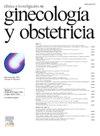Diagnostic rentability of IOTA models for differentiating between benign and malignant complex adnexal masses
IF 0.1
Q4 OBSTETRICS & GYNECOLOGY
Clinica e Investigacion en Ginecologia y Obstetricia
Pub Date : 2024-10-19
DOI:10.1016/j.gine.2024.101000
引用次数: 0
Abstract
Purpose
To evaluate the diagnostic accuracy of the International Ovarian Tumor Analysis (IOTA) Logistic Regression Model 1, 2 (LR1, LR2) ADNEX model and IOTA Simple Rules, in the pre-surgical evaluation of ovarian tumors classified as complex adnexal masses.
Methods
This is a cross-sectional observational study of diagnostic accuracy. We will select patients, who undergo surgical intervention due to adnexal mass with indeterminate, intermediate or high suspicion of malignancy (GI-RADS 4–5), as assessed by an expert ultrasound operator. We analyzed and compared the diagnostic performance and predictive capacity of the different models in the studied population, and also we analyzed each model by creating subgroups based on menopausal status.
Results
One hundred thirty five malignant masses (45%), one hundred forty benign (46.7%) and twenty five border line (8.3%) were included.
LR1 and LR2 models, and ADNEX were applicable to all lesions; however, in 72 lesions (24%), the simple rules were inconclusive.
We observed better performance for LR1 and simple rules, based on the following results: Sensitivity: LR1 91%. Specificity: simple rules 86%. PPV: simple rules 79%. NPV: LR1 88%.
Conclusions
Our study suggests that the subgroup of patients with complex adnexal masses, the IOTA risk stratification through LR1 shows higher sensitivity for risk stratification of malignancy, while simple rules has the highest specificity and diagnostic accuracy. However, it is inconclusive in one out of every four adnexal masses. Additionally, LR1–LR2 and ADNEX do not show significant differences in diagnostic accuracy.
用于区分良性和恶性复杂附件肿块的 IOTA 模型的诊断可租性
目的 评价国际卵巢肿瘤分析(IOTA)逻辑回归模型 1、2(LR1、LR2)ADNEX 模型和 IOTA 简单规则在手术前评估归类为复杂附件肿块的卵巢肿瘤时的诊断准确性。我们将选择因附件肿块而接受手术治疗的患者,由超声波操作专家评估其恶性程度为不确定、中度或高度怀疑(GI-RADS 4-5)。我们分析并比较了不同模型在研究人群中的诊断性能和预测能力,还根据绝经状态创建了亚组,对每个模型进行了分析。LR1和LR2模型以及ADNEX适用于所有病变;然而,在72个病变(24%)中,简单规则无法得出结论:灵敏度灵敏度:LR1 91%。特异性:简单规则为 86%。PPV:简单规则 79%。结论我们的研究表明,在复杂附件肿块患者亚组中,通过 LR1 进行 IOTA 风险分层对恶性肿瘤风险分层的敏感性更高,而简单规则的特异性和诊断准确性最高。然而,每四个附件肿块中就有一个是不确定的。此外,LR1-LR2 和 ADNEX 在诊断准确性上也没有明显差异。
本文章由计算机程序翻译,如有差异,请以英文原文为准。
求助全文
约1分钟内获得全文
求助全文
来源期刊

Clinica e Investigacion en Ginecologia y Obstetricia
OBSTETRICS & GYNECOLOGY-
CiteScore
0.20
自引率
0.00%
发文量
54
期刊介绍:
Una excelente publicación para mantenerse al día en los temas de máximo interés de la ginecología de vanguardia. Resulta idónea tanto para el especialista en ginecología, como en obstetricia o en pediatría, y está presente en los más prestigiosos índices de referencia en medicina.
 求助内容:
求助内容: 应助结果提醒方式:
应助结果提醒方式:


